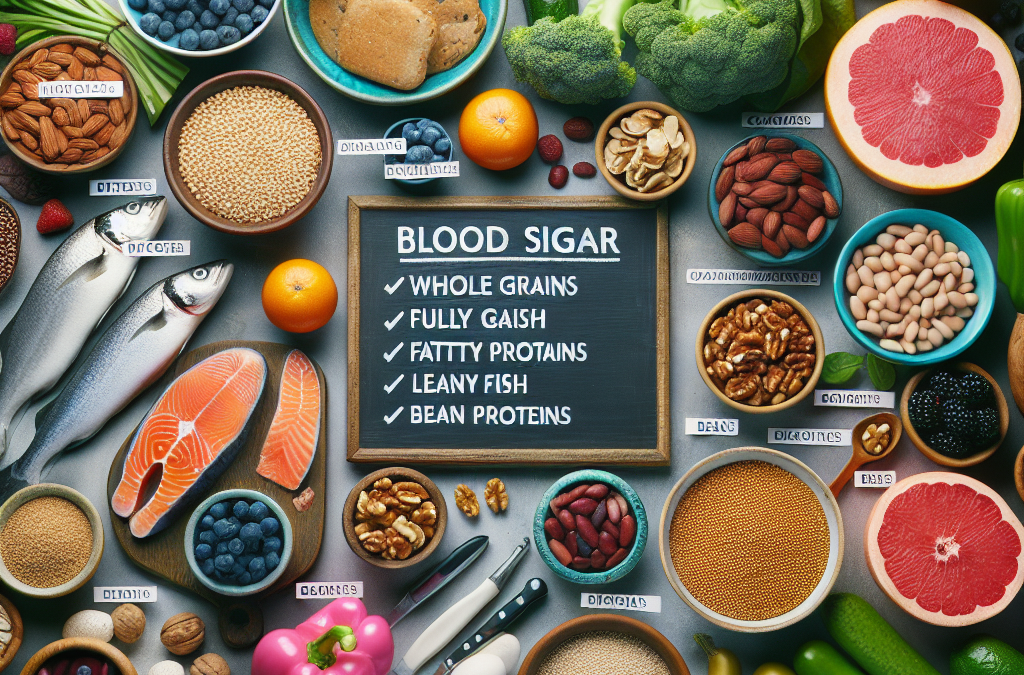1. Leafy Greens
Understanding Their Benefits
From my experience, leafy greens are like the superheroes of diabetes management. They’re packed with nutrients and low in calories, making them a fantastic choice. I’ve found that spinach, kale, and Swiss chard not only add incredible flavor to meals, but they’re also loaded with antioxidants that are crucial for fighting inflammation in the body.
What’s more, these greens contain fiber, which is essential for regulating blood sugar levels. Eating more fiber has really helped me feel full longer and has reduced those annoying sugar spikes after meals. It’s almost like they create a little safety net for my blood sugar!
Plus, leafy greens can easily be incorporated into any dish. Whether it’s a vibrant salad, a savory smoothie, or a simple sauté, I’m always finding new ways to enjoy them. Trust me, your body will thank you.
Best Ways to Prepare Them
I’ve experimented a lot with leafy greens, and one of my absolute favorite ways to prepare them is through steaming or sautéing with a splash of olive oil and garlic. The flavors blend beautifully! If I’m in a hurry, I’ll toss them into a smoothie. A spinach smoothie with some berries? Yes, please!
Another trick I use is adding leafy greens to pasta dishes. Even if it’s just a handful of spinach or arugula, it’s a sneaky way to boost nutrition without compromising on taste. And let me tell you, my pasta dishes have never been more colorful or delicious!
If you think you don’t like greens, I encourage you to try different cooking styles or combinations. You might just surprise yourself with what you enjoy!
Incorporating Into Your Daily Routine
A key takeaway for managing diabetes effectively is making leafy greens a staple in your day-to-day meals. I’ve started keeping pre-washed greens in my fridge so they’re always available. This encourages me to add them to any meal without needing extra preparation time.
For me, it’s all about creating new habits. Adding greens to breakfast, like tossing in some kale with scrambled eggs, has set a positive tone for my day. Who knew greens could be such a great morning power-up?
Lastly, don’t be afraid to experiment! Try different kinds of leafy greens each week and create a rotation. You might find a new favorite that makes managing your diabetes feel effortless and enjoyable.
2. Berries
Why They’re a Great Choice
Let me tell you, berries have been a game-changer for my sweet tooth! Blueberries, strawberries, and raspberries are not only refreshing, but they are also super beneficial for controlling blood sugar levels. They’re low in sugar compared to other fruits, which is a major plus.
Another thing I love about berries is their high fiber content. Fiber helps slow down digestion, which means they’ve become my go-to snack when I need a little energy boost without the sugar crash. My blood sugar levels have been way more stable since I made the switch!
On top of everything, berries are rich in vitamins and antioxidants. They help with inflammation and brain health, which is something we all want to keep in check as we age. So seriously, get those berries into your diet!
Delicious Ways to Enjoy Them
There are endless ways to enjoy berries! I love throwing them into my morning oatmeal or yogurt for a delicious breakfast treat. It really livens things up and adds that touch of natural sweetness that I crave.
If I’m feeling indulgent, I sometimes make a berry compote to drizzle on pancakes or waffles. It’s such an easy process but feels so gourmet! A little simmering with a splash of vanilla and you have yourself a fancy dish.
And don’t forget about snacking! Fresh berries are one of my favorite grab-and-go snacks. I’ll prep a little container with a mix of my favorites and keep it in the fridge for those times when I just need something sweet but healthy.
How to Include More Berries in Your Diet
One simple trick I use is to always have a variety of frozen berries in my freezer. They come in handy for smoothies, baking, or just as a sweet treat on their own—no washing required! Plus, they always seem to taste just as fresh as the day I bought them.
In addition to snacks and breakfast, I’ve found ways to incorporate berries into my lunch salads. A handful of raspberries can really elevate a boring salad and add some zing. Trust me, it makes all the difference!
Explore local farmers’ markets when berry season hits; it’s a great way to support local growers and get the freshest fruits possible. You’ll likely find some varieties you haven’t tried before!
3. Whole Grains
Why They Matter
Whole grains are a staple in my pantry and for good reason. Unlike refined grains, whole grains retain all parts of the grain, which means they come loaded with nutrients and fiber. Foods like quinoa, brown rice, and whole grain bread have become essential parts of my meals.
Including whole grains in my diet has significantly improved how I manage my blood sugar. The high fiber content slows down the sugar absorption, which keeps my blood glucose levels more stable throughout the day. I also feel fuller longer, which helps curb any unnecessary snack attacks later.
Plus, whole grains are incredibly versatile! Whether it’s a hearty bowl of quinoa salad or a simple slice of whole grain toast, there’s just so much you can do with them. They’re great for adding texture and flavor to any recipe!
Favorite Whole Grain Recipes
One go-to recipe of mine is a savory quinoa bowl. I love combining cooked quinoa with sautéed veggies, some chickpeas, and a drizzle of tahini sauce. Not only is it delicious, but it’s also a bowl packed with nutrients that keeps my energy levels high!
I also adore making overnight oats with whole rolled oats, topped with nuts and berries. Seriously, it’s a scrumptious and filling breakfast that helps kickstart my day.
Yeah, and you know, whole grain pasta isn’t just for Italian; a simple whole grain pasta with pesto and seasonal veggies can be a delightful dinner option. You just can’t go wrong!
Tips for Incorporation
One of the easiest ways to incorporate whole grains is to replace refined grains in your meals gradually. Start by substituting white rice for brown rice or quinoa. It’s simple and you’ll start to feel the difference.
Get an Amazing Discount on the Best Certified Organic Whole Food Supplement!
Reading labels becomes super essential. I look for products that list “whole grain” as the first ingredient. It’s especially important for things like bread and cereals where it can be tricky.
And honestly, don’t be afraid of experimenting! Try new grains like barley or farro. It’s all about making meals exciting while keeping health in mind. Your taste buds will thank you!
4. Nuts and Seeds
Why They’re Important
Nuts and seeds are like little powerhouses of nutrition! They’re full of healthy fats, protein, and fiber, all of which are crucial for managing diabetes. From almonds to chia seeds, I’ve found them to be incredibly satisfying snacks that keep my cravings at bay.
Incorporating these into your diet can be a game-changer for blood sugar control. The fats in nuts and seeds help slow down digestion, leading to more stable blood sugar levels post-meal. Plus, I love how versatile they are; you can toss them in just about anything!
They also make for an easy snack when I’m on the go. Instead of diving into a bag of chips, I grab a small handful of nuts. It’s a much better choice, and my body feels a lot happier for it!
Tasty Ways to Enjoy Them
I’ve gotten really creative with nuts and seeds in my cooking. One of my favorite things is to sprinkle them on salads for a little added crunch. It just takes that meal to a whole new level! Plus, they provide a nice protein boost as well.
Nut butters are also a staple in my house. I love natural almond butter on whole grain toast for breakfast. Add a sprinkle of cinnamon, and you’ve got a treat that’s nutritious and delicious!
Chia seeds have also become a staple in my morning routine. I love making chia pudding with almond milk and a bit of honey—so simple, yet so satisfying. It’s a great way to get some healthy fats in first thing!
Adding More Nuts and Seeds into Your Meals
To add more nuts and seeds into my diet, I keep a variety on hand. I like to mix them up in a jar and keep them by my kitchen counter. It’s a fantastic way to encourage my snacking habits toward healthier choices.
Another strategy is to make trail mix with my favorite nuts and some dried fruit. This combo works wonders during long workdays or road trips, where I want to avoid unhealthy snack options.
Lastly, consider using ground nuts or seeds as a topping. Sprinkle them on oatmeal or yogurt, and it not only tastes good but looks pretty too. Presentation matters, right?
5. Healthy Fats
Understanding Their Importance
Healthy fats, like those found in avocados and olive oil, are crucial in my diet. They help to balance blood sugar levels, which is so important. Including these fats provides a satisfying feeling of fullness which curbs my cravings for unhealthy snacks.
I can’t stress enough how incorporating healthy fats has made such a difference in my meals. They give me energy without spiking my blood sugar, something I’ve been mindful of since my diabetes management journey started.
Fatty fish, like salmon, are also amazing for their omega-3 fatty acids. I try to have fish a couple of times a week. It feels good knowing I’m fueling my body with the good stuff!
How to Include Healthy Fats in Your Meals
One of my favorite ways to enjoy healthy fats is through an avocado toast, topped with a sprinkle of sea salt and some pepper. It’s quick, easy, and totally satisfying. It’s like a mini-meal for breakfast that keeps me full for hours.
Cooking with olive oil instead of butter has also been a game changer. I use it in everything from sautéing to drizzling over salads. The flavor it adds is fantastic, plus it’s much healthier.
And don’t forget about making salads robust with healthy fats. Toss in some nuts or seeds and even some sliced avocado, and you’ve got yourself a nutrient-dense meal that fills you up!
Creating Your Fat-Friendly Kitchen
In my kitchen, I ensure I always have avocados, natural nut butters, and good-quality olive oil stocked up. It makes it so much easier to whip up healthy dishes without a second thought.
When meal prepping, I’ve found making dressings with olive oil and vinegar keeps my salads exciting and flavorful! It saves me from those store-bought options that might contain hidden sugars.
Ultimately, using healthy fats mindfully has turned cooking into a joy. It gives every dish a delightful richness without the guilt, and it’s become a part of my everyday lifestyle.
FAQ
1. What are the top foods for managing diabetes?
Leafy greens, berries, whole grains, nuts and seeds, and healthy fats are all excellent choices. They help control blood sugar levels and provide essential nutrients.
2. How can I incorporate more leafy greens into my diet?
You can add them to smoothies, salads, and breakfast dishes. Keeping pre-washed greens on hand makes it easier to include them in meals.
3. What are some creative ways to eat berries?
We can use berries in oatmeal, smoothies, or as a topping on yogurt. They’re also great in salads or as a sweet snack on their own!
4. Are nuts and seeds healthy for diabetic diets?
Absolutely! Nuts and seeds are high in healthy fats, fiber, and protein, which are all beneficial for blood sugar control.
5. How do healthy fats help with diabetes management?
Healthy fats slow down digestion and promote satiety. They help keep blood sugar levels stable and provide essential nutrients that improve overall health.




